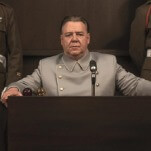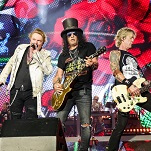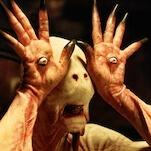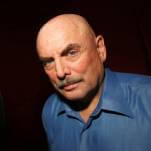3. K.A. Applegate
Young-adult author Katherine Applegate wrote the first 24 books in her science-fiction series Animorphs, which established the series as a bestseller. But most of the books between 25 and 52 were written by one of 12 different ghostwriters, picked from Applegate’s former editors or writing students. Applegate wrote outlines—which didn’t always turn out to be especially detailed—that served as guidelines used to turn around a draft in just a few months, before Applegate (and her husband/co-creator Michael Grant) or her series editor, Tonya Alicia Martin, would take a pass to keep it within series continuity. Though the books still carried Applegate’s name, each ghostwriter was credited on the dedication page in a boilerplate acknowledgement. Applegate’s 2011 Reddit AMA revealed more information behind the ghostwriting, took the blame for narrative lapses, and owned up to being difficult to work with throughout the process. It’s a rare instance of publicly revealing the steps that went into the extensive use of ghostwriters (and the start of her writing career as a ghostwriter), and credit to Applegate for owning up to how the accelerated outline-to-novel editing process ended up straining her professional relationships with the various writers.
4. V.C. Andrews
At the time of Cleo Virginia Andrews’ death from breast cancer in 1986, her seven completed novels as V.C. Andrews had already become bestsellers as a combination of rags-to-riches romance with some graphic forbidden love, often incest. But her family saw the value of a franchise name, and hired a ghostwriter to complete the unfinished works left behind after Andrews’ death, then continue writing books to fit in with the franchise style. Since 1990, every book carrying the V.C. Andrews moniker has been under the guise of a ghostwriter—with the exception of the standalone sci-fi novel Gods Of Green Mountain, published as an e-book in 2004. The identity isn’t a well-kept secret: The Devil’s Advocate author Andrew Neiderman. Neiderman has published more than 70 works under the V.C. Andrews name, with at least four more scheduled in the next two years, continuing Andrews’ publishing legacy more than 25 years after her death.
5. Mickey Spillane
When Mickey Spillane was in his prime, it wasn’t unusual for him to turn out a couple of new books in a year, but his publication rate dropped off as he grew older and his health declined. Spillane died in 2006, and the next year, Hard Case Crime published a posthumous novel, Dead Street. Spillane’s name was on the cover all by itself, but the copyright page included the discreet credit: “Prepared for publication by Max Allan Collins.” Collins, Spillane’s literary executor, is a prolific crime writer who, back in 1977, had taken over the writing of the Dick Tracy comic strip from its creator, Chester Gould. In 2008, Harcourt put out The Goliath Bone, the first of three reported Mike Hammer novels that Collins had agreed to “complete.” Spillane’s name was on the cover in big letters; beneath it, in smaller letters, were the words, “with Max Allan Collins.” Six new Spillane books have appeared since 2006, with a seventh planned for 2014. That’s almost as many books as Spillane published during the last 35 years of his life. And Collins’ name keeps getting bigger on the covers, which may be a reflection of just how much “completing” he now has to do.
6. Tom Clancy
With his military-hardware potboilers and book dedications to Ronald Reagan, Tom Clancy was the unofficial pulp laureate of the Reagan administration. He must have also been a fan of Reagan’s environmental policies, because in his quest to keep a steady stream of product flowing to market, he’s basically strip-mined his own name. Clancy and his business partner Steve Pieczenik “co-created” three long-running book series—Op-Center, Net Force, and its young-adult offshoot, Net Force Explorers—each of which features the possessive “Tom Clancy’s” in the title. Neither of the co-creators actually write; Pieczenik hires the hacks and packaging agents, and Clancy holds up his end by being named Tom Clancy. There’s also Tom Clancy’s Power Plays, a series Clancy co-created with the late Martin H. Greenberg, which served as a launching pad for a few of the many video games, and even board games, that are also branded with Clancy’s name. (Some of the video games also inspired their own spin-off books series.) Just keeping track of all this may not leave a man much time for writing, so it’s not surprising that all four of the “real” Tom Clancy novels that have appeared since 2010 credit co-authors, whose names are in teensy-weensy print below Clancy’s name on the book jackets.
7. Isaac Asimov
In the early decades of science-fiction writing, virtually every story involving robots was a variation on the Frankenstein theme. Isaac Asimov changed all that with a series of short stories that argued that, if humans build automobiles and power tools with safeguards, why wouldn’t they do the same with robots? Those safeguards became one of the most influential ideas in sci-fi, the Three Laws Of Robotics, which ensured a robot could not harm a human, disobey orders, or endanger itself needlessly. The concept appears as an unwritten rule behind fictional robots from R2-D2 to Data. Asimov returned to robots and the Three Laws throughout his career, but in the late ’80s, he also issued a challenge to his fellow writers, to come up with stories that explore the world established in his robot stories. The result was Isaac Asimov’s Robot City, a series of six novels, each by a separate author (though William F. Wu wrote the third and sixth), built around an amnesiac exploring a city with no human occupants, just robots built for some mysterious purpose. Each writer continues the story told by the previous one, and a second series, Robots And Aliens, soon followed. While the ideas on display weren’t always as interesting as the original, each book had a compelling central mystery, and for an Asimov fan, it was fun to see other writers taking turns playing in the sandbox he had built.







































